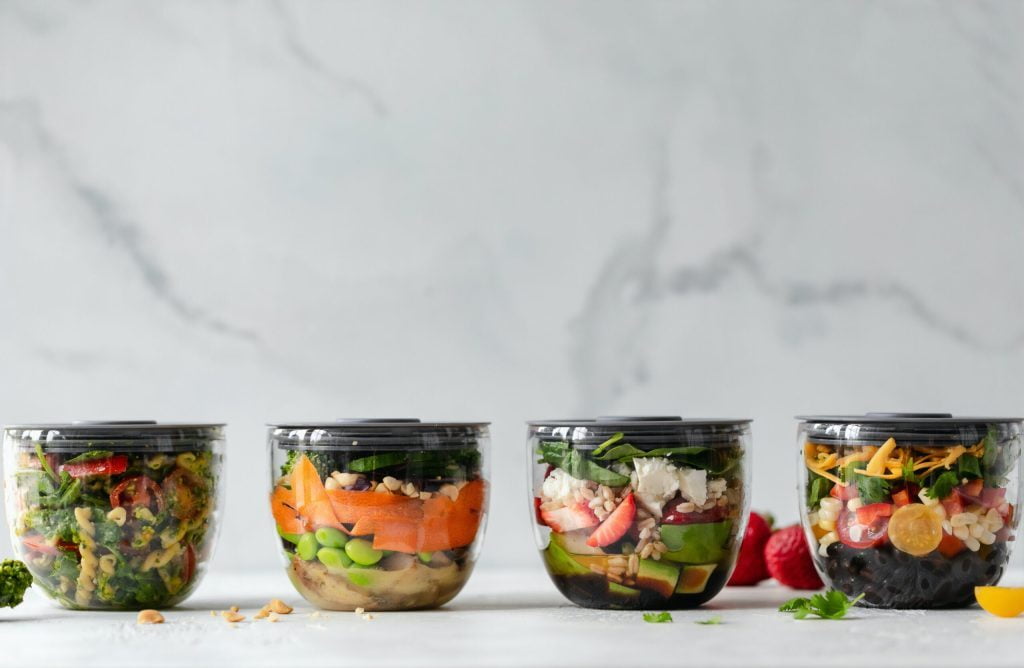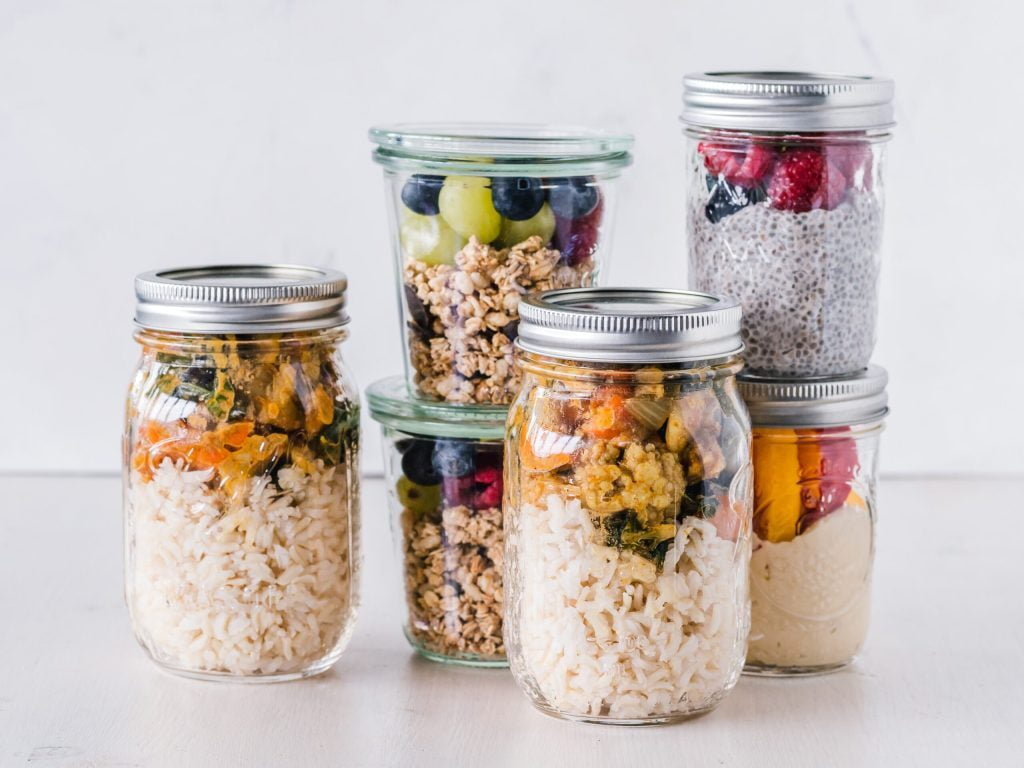That said, today I thought I’d share with with you my strategy for simplifying eating when my schedule seems overpacked and my healthy eating habits begin to wane.
Okay, let’s talk meal planning because it is the #1 strategy I use and I suggest to clients when life gets busy and unhealthy habits rule the day. What I love about meal planning is that first and foremost it allows me to eat real food. While there’s nothing wrong with an occasional stop at Chick-fil-a (does anyone love their nuggets as much as I do?), I try to make the bulk of my diet consist of less processed, whole foods. And meal planning allows me to do just that because I’m in control of exactly what I put on my plate.

Secondly, meal planning saves me time. If I prep most meals/ingredients on one day of the week it also means one stop at the grocery store, one time turning on my stove, and one time making a disaster of a mess in my kitchen!
Lastly, meal planning saves me major bucks. Do you realize how expensive it is to eat out these days? If I go to fast-food concept over my lunch hour, I’m easily forking over $10-15 for a meal. And if I eat out 5 days a week, I could be spending as much as $300 per month (and that’s only lunch)! This is unreal to me. Once I did the math, I realized one of the best ways to stay within my budget is by cooking my own food. So there it is!
The Plate Method of Meal Prep
While there are different ways to approach meal planning, I typically utilize the ‘plate method’ for planning. What is the plate method? Let me explain. When I think about eating a balanced meal I think about a balance of carbohydrates, protein, and fat (aka macronutrients). To me, a nutritionally balance meal visually looks like this: half of your plate is filled with non-starchy/low-carbohydrate vegetables (think leafy greens, broccoli, cauliflower, etc.), one-fourth of your plate is filled with lean protein or fatty fish (e.g., meat, seafood, beans), and the last quarter of your plate is filled with starches/carbohydrates (e.g., sweet potatoes, butternut squash, whole grains, and/or fruit).
This way of eating lends nicely to the component meal prep method. What’s component meal prep? Let me explain. Basically, it’s cooking several different vegetables, proteins, and starches that can be used later in the week to compose meals. The beauty of this method is that you can multi-purpose ingredients and make several different combinations of fully composed meals.
Want to try out plate method meal prep? Here are a few basic combinations to stir up your own creativity.
- Cucumbers in Dill Yogurt Sauce, Grilled Salmon and Roasted Sweet Potato Wedges
- Roasted Broccoli, Cauliflower & Red Peppers, Scrambled Eggs and Steamed Brown Rice (mix together for a veggie fried rice)
- Grilled Asparagus, Pork Loin and Quinoa
- Green Beans, Turkey Meatball and Whole Grain Spaghetti with Marinara

While I find the plate method/component meal prep to be a simple and healthy approach to meal planning—it may not work for everyone. Traditional meal planning, where one makes full assembled combination dishes (think casseroles, soups, stir fries) is also a good option. However, from a nutrition perspective, I find the plate method to be an easy way to adopt a healthy pattern of eating. That’s because it ensures you are getting a balanced macronutrient profile in each meal, and your able to flex ingredient portions according to your level of hunger for that day. Interested in trying component meal prep out? Just comment on this post and I’ll send you my brand new weekday meal plan for FREE!
My Top 10 Tips for Meal Planning
No matter what type of meal you want to make (plated meal or combination meal), here are some tips to make your meal planning a breeze.
- Don’t reinvent the ‘wheel’ or plate so to speak; utilize the recipes your family loves–and those that are tried and true. You are more likely to make recipes that you can confidently say work.
- Consider creating a themed meal planning template and stick with it. For example, Slow-Cooker Sunday, Leftover Monday, Taco Tuesday, Italian Wednesday, Take-Out Thursday, and so forth. Sticking with a themed menu each week is a great way to add variety to your diet and prevent recipe boredom.
- Choose recipes with overlapping ingredients. For example, multipurpose a rotisserie chicken by using half to make chicken enchiladas and the other half for chicken salad sandwiches.
- Cook once and eat twice! Whenever you meal prep – consider doubling or even tripling your recipe and stash the meals away in the freezer. This is a great time saver and you only dirty dishes one time as opposed to two or three times. If you need some ideas on what meals freeze well, check out these recipes from Pinch of Yum.
- Start off slow with meal planning. There is no reason to try to prep a weeks worth of fully prepared/assembled meals in one afternoon. I’m overwhelmed just thinking about that. Instead, try component meal prep or make a couple of fully assembled meals.
- Take inventory. When you meal prep—you want to make sure that you have everything you need going into it. Before shopping for your ingredients, check out your pantry, fridge, and freezer to see what you have on stock. Also, make sure that you have the right cooking equipment and storage containers for your meals. I’m a huge fan of glass containers because they are easy to clean, durable, and can be stored in the fridge, freezer, or even reheated in the oven. I recently bought this container set from Amazon and I’m in love with them.
- Plan a time to grocery shop. Early mornings are best to shop as everything has been re-stocked from the night before and there are minimal bodies you have to maneuver around. Also, consider online grocery shopping, curb-side pick up, or delivery.
- Choose ingredients with less prep and less waste! One of the best ways to save time with meal prep is to choose ingredients that are pre-prepped or ready-to-cook. Here are some of my picks:
- Rotisserie Chicken
- Spiralized Vegetables
- Pre-Washed/Cut Veggies
- Precooked Grains
- Canned Beans
- Frozen Fruits/Veggies
- Make best friends with the bulk food section. Need a teaspoon of turmeric but don’t want to buy the entire bottle? Shop the bulk food section to get the exact amount of curry, coconut flour, red lentils, and so forth. This is a great way to avoid ingredients going bad in your pantry.
- Finally, if you tried meal prepping and you simply aren’t having success with it—there is no shame in seeking help. There are some great meal planning sites and apps where all you have to do is select your recipes and the app will automatically generate a grocery list and meal prep schedule for you.